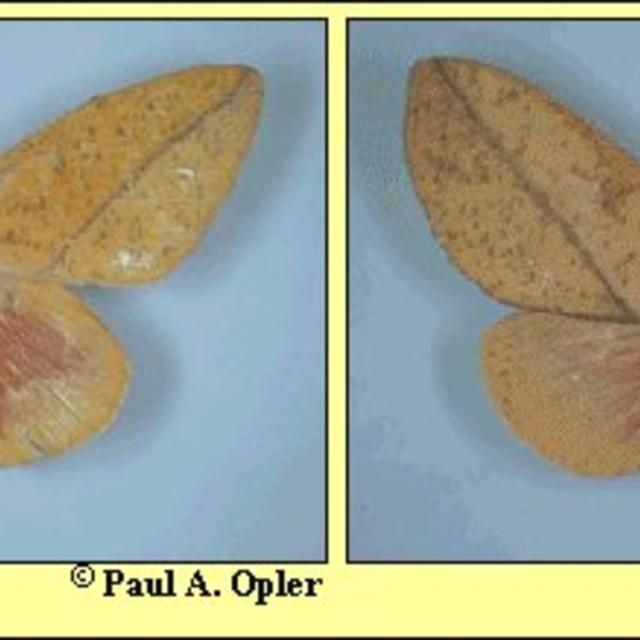Bisected honey locust moth
Sphingicampa bisecta
Family: Saturniidae
Subfamily: Ceratocampinae
Identification: Females are larger than males. Upperside of male ranges from yellow to orange, female is usually yellow. Both sexes have red patches of varying sizes on the hindwings. Postmedian line on forewing is distinct and almost straight. Females have varying amounts of dark specks which are often gathered in the forewing cell and appear as a dark spot; males usually have no speckling.
Wing Span: 2 1/16 - 2 15/16 inches (5.3 - 7.5 cm).
Life History: Adults emerge in the late afternoon and mate late that evening and into the next morning. After dusk, females begin laying eggs singly or in pairs on leaves of the host plants. Caterpillars of the summer brood pupate and overwinter in shallow underground chambers.
Flight: Two flights from April-June and July-September.
Caterpillar Hosts: Honey locust (Gleditsia triacanthos) and Kentucky coffee tree (Gymnocladus dioicus).
Adult Food: Adults do not feed.
Habitat: Deciduous woodland.
Range: Central Ohio west to southern Iowa; south to northern Georgia, central Alabama, Mississippi, Louisiana, and east Texas.
Conservation: Not usually required.
NCGR: G5 - Demonstrably secure globally, though it may be quite rare in parts of its range, especially at the periphery.
Management Needs: None reported.
Comments: NULL
Get your BAMONA Gear!
Please donate!
We depend on donations to keep Butterflies and Moths of North America freely available. We want to express our gratitude to all who showed their support by making a contribution this year. You can donate to support this project at any time.
Advertise with us!
Do you have a product or service that you think would interest BAMONA users? If you would like to advertise on this website, contact us by email, or use the contact form and select the "Advertising" category.
Verified Sightings
Displaying 25 - 48 of 257 verified sightings

Observation date: Jul 01, 2015
Submitted by: Jeff Trahan
Region: Bossier Parish, Louisiana, United States
Verified by: Jeff Trahan
Verified date: Jul 20, 2015

Observation date: Jun 27, 2015
Submitted by: Jeff Trahan
Region: Bossier Parish, Louisiana, United States
Verified by: Jeff Trahan
Verified date: Jun 28, 2015

Observation date: Aug 15, 2014
Submitted by: sgrisanti
Region: Hamilton County, Ohio, United States
Verified by: rogerdowner
Verified date: Aug 15, 2014

Observation date: Aug 02, 2013
Submitted by: KristyBaker
Region: Rutherford County, Tennessee, United States
Verified by: Don Tangren
Verified date: Aug 16, 2013

Observation date: Jul 27, 2013
Submitted by: marcia_morris
Region: Rockingham County, Virginia, United States
Verified by: rogerdowner
Verified date: Aug 09, 2013

Observation date: May 25, 2012
Submitted by: Bachasaur
Region: St. Martin Parish, Louisiana, United States
Verified by: rogerdowner
Verified date: Nov 15, 2012

Observation date: May 22, 2012
Submitted by: Bachasaur
Region: Ascension Parish, Louisiana, United States
Verified by: rickypatterson
Verified date: Jun 19, 2012

Observation date: unknown
Submitted by: BAMONA
Region:
Verified by: BAMONA
Verified date: Sep 06, 2010
Observation date: Aug 01, 1975
Submitted by: legacy.reporter (Conner, Jeff)
Region: Sullivan County, Missouri, United States
Verified by: legacy.verifier (Phillip Koenig; Heitzman, J.R.)
Verified date: Mar 05, 2009
Observation date: Aug 10, 1991
Submitted by: legacy.reporter (Winkler, George)
Region: Ste Genevieve County, Missouri, United States
Verified by: legacy.verifier (Phillip Koenig; Winkler, George)
Verified date: Mar 05, 2009
Observation date: Jan 01, 1987
Submitted by: legacy.reporter (Rohrbach, Ray)
Region: Callaway County, Missouri, United States
Verified by: legacy.verifier (Phillip Koenig; Heitzman, J.R.)
Verified date: Mar 05, 2009
Observation date: Jun 18, 1972
Submitted by: legacy.reporter (Tietsort, Rene)
Region: Harrison County, Missouri, United States
Verified by: legacy.verifier (Phillip Koenig; Heitzman, J.R.)
Verified date: Mar 05, 2009
Observation date: Sep 09, 1978
Submitted by: legacy.reporter
Region: Linn County, Missouri, United States
Verified by: Phillip E. Koenig (Phillip Koenig)
Verified date: Mar 05, 2009
Observation date: unknown
Submitted by: legacy.reporter (Willis, Daryl)
Region: Livingston County, Missouri, United States
Verified by: Phillip E. Koenig (Phillip Koenig)
Verified date: Mar 05, 2009
Observation date: Jan 01, 1987
Submitted by: legacy.reporter (Ellis, Scott)
Region: Ray County, Missouri, United States
Verified by: legacy.verifier (Phillip Koenig; Heitzman, J.R.)
Verified date: Mar 05, 2009
Observation date: Aug 05, 1974
Submitted by: legacy.reporter (Carlton, Matthew)
Region: McDonald County, Missouri, United States
Verified by: legacy.verifier (Phillip Koenig; Heitzman, J.R.)
Verified date: Mar 05, 2009
Observation date: Jun 10, 1990
Submitted by: legacy.reporter (Winter, Dave)
Region: Wayne County, Missouri, United States
Verified by: Phillip E. Koenig (Phillip Koenig)
Verified date: Mar 05, 2009
Observation date: Jan 01, 1980
Submitted by: legacy.reporter (Lentz, Mike)
Region: Pettis County, Missouri, United States
Verified by: legacy.verifier (Phillip Koenig; Heitzman, J.R.)
Verified date: Mar 05, 2009
Observation date: Aug 29, 1971
Submitted by: legacy.reporter (Funk, R.)
Region: Shannon County, Missouri, United States
Verified by: Phillip E. Koenig (Phillip Koenig)
Verified date: Mar 05, 2009
Observation date: Jul 15, 1975
Submitted by: legacy.reporter (Smith, Jim)
Region: Montgomery County, Missouri, United States
Verified by: Phillip E. Koenig (Phillip Koenig)
Verified date: Mar 05, 2009
Observation date: Jun 21, 1976
Submitted by: legacy.reporter
Region: Douglas County, Missouri, United States
Verified by: Phillip E. Koenig (Phillip Koenig)
Verified date: Mar 05, 2009
Observation date: Aug 20, 1996
Submitted by: legacy.reporter (Smart, Glen)
Region: Cape Girardeau County, Missouri, United States
Verified by: Phillip E. Koenig (Phillip Koenig)
Verified date: Mar 05, 2009
Observation date: Jan 01, 1987
Submitted by: legacy.reporter (Lambeth, Kelli)
Region: Jasper County, Missouri, United States
Verified by: legacy.verifier (Phillip Koenig; Heitzman, J.R.)
Verified date: Mar 05, 2009
Observation date: Jun 23, 1973
Submitted by: legacy.reporter (Rohlfing, Roger)
Region: St. Clair County, Missouri, United States
Verified by: legacy.verifier (Phillip Koenig; Heitzman, J.R.)
Verified date: Mar 05, 2009
- ‹ previous
- 2 of 11
- next ›



